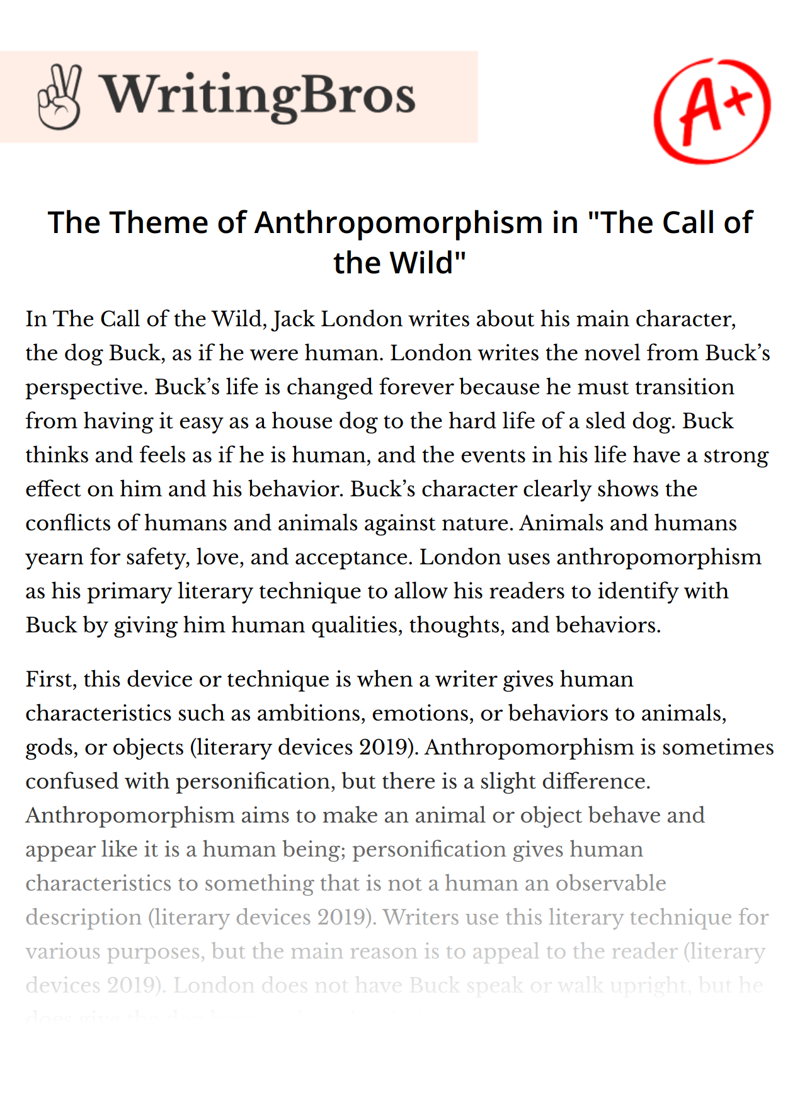The Theme of Anthropomorphism in "The Call of the Wild"

In The Call of the Wild, Jack London writes about his main character, the dog Buck, as if he were human. London writes the novel from Buck’s perspective. Buck’s life is changed forever because he must transition from having it easy as a house dog to the hard life of a sled dog. Buck thinks and feels as if he is human, and the events in his life have a strong effect on him and his behavior. Buck’s character clearly shows the conflicts of humans and animals against nature. Animals and humans yearn for safety, love, and acceptance. London uses anthropomorphism as his primary literary technique to allow his readers to identify with Buck by giving him human qualities, thoughts, and behaviors.
First, this device or technique is when a writer gives human characteristics such as ambitions, emotions, or behaviors to animals, gods, or objects (literary devices 2019). Anthropomorphism is sometimes confused with personification, but there is a slight difference. Anthropomorphism aims to make an animal or object behave and appear like it is a human being; personification gives human characteristics to something that is not a human an observable description (literary devices 2019). Writers use this literary technique for various purposes, but the main reason is to appeal to the reader (literary devices 2019). London does not have Buck speak or walk upright, but he does give the dog human thoughts, behaviors, and emotions (The Call of the Wild Study Guide 5).
Second, London uses anthropomorphism to represent Buck’s human qualities throughout the entire piece by detailing his emotions and feelings (eNotes 2010). Buck feels and expresses emotions like a human. He exhibits outrage, turmoil, hostility, love, and loyalty a colorful amount of times all through the novel (eNotes 2010). At the beginning of the novel, London can illustrate Buck’s human qualities by describing his crushing feelings of anger and hostility after he is taken (eNotes 2010). After he is taken, Buck plots how he will get his revenge on the humans who took him. London utilizes anthropomorphism by writing, “They would never get another rope around his neck. Upon that he was resolved. For two days and nights he neither ate nor drank, and during those two days and nights of torment, he accumulated a fund of wrath that boded ill for whoever first fell foul of him” (London 10). London depicts Buck’s emotions of deep love and loyalty by using Buck’s relationship with John Thorton. After Thornton was violently killed, Buck returns to the site of his owner’s death every year to show his love, respect, and loyalty were truly undying (eNotes 2010). This friendship allowed him to cope, prosper, and survive.
Equally important, London uses anthropomorphism to show how Buck thinks and reasons like a human. Some people may question whether a dog or animal can think. London’s portrayal of Buck is convincing enough to the audience and writes, “ Sometimes he thought of Judge Miller’s big house in the sun-kissed Santa Clara Valley, and of the cement swimming tank, and Ysabel, the Mexican hairless, and Toots, the Japanese pug; but oftener he remembered the man in the red sweater, the death of Curly, the great fight with Spitz, and the good things he had eaten or would like to eat” (London 41). In this excerpt, Buck is sitting by the fire and thinking about his past life. He is thinking about his family, previous canines, and his beginnings (eNotes 2010).
Finally, London uses anthropomorphism to show that Buck exhibits the human behavior of perseverance. The title of Chapter Two, “The Law of Club and Fang”, is an example of how Buck learns that perseverance was required to survive in the extreme wilderness (London 15).
London writes, “He was a killer, a thing that preyed, living on things that lived unaided, alone by virtue of his own strength and prowess, surviving triumphantly in a hostile environment where only the strong survive” (London 77). This illustrates the understanding Buck has to quickly adapt to his surroundings and he must do whatever it takes to survive. The detailed anthropomorphism London uses, depicts the human behavior of perseverance to show that only the strongest survive.
By using anthropomorphism in The Call of the Wild, Jack London allows the reader to realize that humans and animals have traits capable of being both cultured and wild. Also, this device allows the reader to make the connection between people and animals. By making the connection, it allows the audience to realize that good and evil exist in the world. In life, humans and animals want to feel secure, to feel love, to feel success, and be a part of a family. This literary technique allows London to tell the story and the reader to identify with Buck, because people feel the same anger, have true loyal friendships, think back on past experiences, and never lose sight of a goal.
Cite this Essay
To export a reference to this article please select a referencing style below

